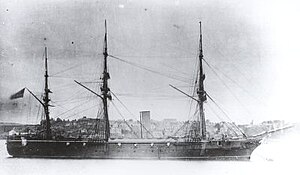HMS Amethyst (1873)

Amethyst at anchor
|
|
| History | |
|---|---|
|
|
|
| Name: | HMS Amethyst |
| Namesake: | Amethyst |
| Builder: | Devonport Dockyard |
| Cost: | Approximately £77,000 |
| Laid down: | 1872 |
| Launched: | 19 April 1873 |
| Completed: | July 1873 |
| Fate: | Sold for scrap, November 1887 |
| General characteristics (as built) | |
| Class and type: | Amethyst-class wooden screw corvette |
| Tonnage: | 1,405 bm |
| Displacement: | 1,934 long tons (1,965 t) |
| Length: | 220 ft (67.1 m) (p/p) |
| Beam: | 37 ft (11.3 m) |
| Draught: | 18 ft (5.5 m) |
| Installed power: | 2,144 ihp (1,599 kW) |
| Propulsion: |
|
| Sail plan: | Ship rig |
| Speed: | 13 knots (24 km/h; 15 mph) |
| Range: | 2,060–2,500 nmi (3,820–4,630 km; 2,370–2,880 mi) at 10 knots (19 km/h; 12 mph) |
| Complement: | 225 |
| Armament: | |
HMS Amethyst was the lead ship of the Amethyst-class corvettes built for the Royal Navy in the early 1870s. She participated in the Third Anglo-Ashanti War in 1873 before serving as the senior officer's ship for the South American side of the South Atlantic. The ship was transferred to the Pacific Station in 1875 and fought in the Battle of Pacocha against the rebellious Peruvian ironclad warship Huáscar two years later. This made her the only British wooden sailing ship ever to fight an armoured opponent. After a lengthy refit, Amethyst again served as the senior officer's ship on the South American station from 1882–85. She was sold for scrap two years later.
Amethyst was 220 feet (67.1 m) long between perpendiculars, had a beam of 37 feet (11.3 m) and had a draught of 18 feet (5.5 m). The ship displaced 1,934 long tons (1,965 t) and had a burthen of 1,405 tons. Her crew consisted of 225 officers and enlisted men. Unlike her iron-hulled contemporaries, the ship's wooden hull prevented any use of watertight transverse bulkheads.
The ship had one two-cylinder horizontal compound expansion steam engine made by J. & G. Rennie, driving a single 15-foot (4.6 m) propeller. Six cylindrical boilers provided steam to the engine at a working pressure of 60 psi (414 kPa; 4 kgf/cm2). The engine produced a total of 2,144 indicated horsepower (1,599 kW) which gave Amethyst a maximum speed of 13.244 knots (24.528 km/h; 15.241 mph) during her sea trials. The ship carried 270 long tons (270 t) of coal, enough to steam between 2,060–2,500 nautical miles (3,820–4,630 km; 2,370–2,880 mi) at 10 knots (19 km/h; 12 mph).Amethyst was ship rigged and had a sail area of 18,000 square feet (1,672 m2). The lower masts were made of iron, but the other masts were wood. The ship, and her sisters, were excellent sailors and their best speed under sail alone was approximately that while under steam. Ballard says that all the ships of this class demonstrated "excellent qualities of handiness, steadiness and seaworthiness". Her propeller could be hoisted up into the stern of the ship to reduce drag while under sail. During her refit in 1878, Amethyst was re-rigged as a barque.
...
Wikipedia
